Allen Rice Moore
1865-1922

![]()
Life Of A.R. Moore
THE subject of this sketch came of Disciple stock, and for over 30 years he has been an earnest student of the writings of Alexander Campbell. He has, therefore, like Timothy, inherited a splendid background for his fine Christian character.
Allen R. Moore was born and reared within five miles of Old Cane Ridge at North Middletown, Bourbon Co. Kentucky, August 31, 1865. His grandfather came into the Disciple Movement under “Raccoon" John Smith. Allen became a Christian at the age of ten years, Moses E. Lard taking his confession and John S. Sweeney baptizing him. At the age of eighteen, he graduated at Kentucky Classical and Business College, under the presidency of E. V. Zollars, taking the A.B. degree and delivering the Greek oration on Commencement day. At the age 20 he graduated in the Classical Department of the College of the Bible, which was at that time under the administration of that famous triumvirate, John W. McGarvey, Robert Graham and I. B. Grubbs. Among the pastorates he has held are churches in Richmond, Va., St. Paul, Minn., Memphis, Tenn., Lancaster, Ky., Birmingham, Ala., and Savannah, Ga., where he now ministers. He was ten years in Birmingham, and is in his fifth year in Savannah. He has bad considerable experience as an editor, having been editor of the Missionary Weekly and Assistant Editor of the Christian Guide. He is a frequent contributor to The "Christian Evangelist" and "The Christian Standard." He is the author of two books: a small volume, "Alexander Campbell and the General Convention;" and a book of sermons on The Acts of Apostles, entitled “The Gospel According to the Holy Spirit." A few years ago he visited the Holy Land and studied the places made famous in the life of our Savior, and was greatly stimulated in his interest in Bible study and Bible teaching.
Allen R. Moore is a preacher of no mean ability, but his success is as much owing to his heart power as to his intellectual attainments. This is why he is very popular with the people he serves. Among the Disciple preachers of the south he is distinguished as a leader in the worthy enterprises of the churches, and he can always be counted on the side of those who are in favor of legitimate progress. He not only bas convictions, but has the courage of these and when necessary, be is not afraid to speak and act without any regard to his personal interests.
Mr. Moore has exerted a healthful influence for the Restoration Movement throughout several of the Southern states. He has contended for the best ideals of the Movement with an earnestness and faithfulness which has done much to counteract certain tendencies, the checking of which needed his wise and strong advocacy.
-W.T. Moore, New Living Pulpit Of The Christian Church, page 387
![]()
THE HOUSE BEAUTIFUL
a sermon by Allen R. Moore
TEXT.-“So Solomon overlaid the house within with pure gold and he drew chains of gold across before the oracle; and he overlaid it with gold. And the whole house he overlaid with gold, until the house was finished: also the whole altar that belonged to the oracle he overlaid with gold." - 1 Kings 6:21, 22.
“Know ye not that we are the temple of God, and that the Spirit of God dwelleth in you? If any man destroyeth the temple of God, him shall God destroy; for the temple of God is holy, and such are ye." - 1 Corinthians 3:16,17.
WE live in a beautiful world. God has endowed us with a love for the beautiful and surrounded us with abundant material with which to satisfy that love. In nature, in art, in religion, we are lovers of the beautiful.
When David had established his kingdom and had grown great and rich, he desired to build a house for the worship of God. He had already built the king's palace of cedar wood, and he felt ashamed to live in such splendor while the ark of God still rested in a tent. But God forbade David to build a temple. He had been a man of war and blood and it was not fitting that he build the temple, lest the nations say that Jehovah's religion is established by the conquest of the sword and the house built with the spoils of war. But God said to David, "When thy days are fulfilled, and thou shalt sleep with thy fathers, I will set up thy seed after thee, that shall proceed out of thy bowels, and I will establish his kingdom. He shall build a house for my name, and I will establish the throne of his kingdom forever."
This must have been a disappointment to David, for he had set his heart upon building the house; yet, he was deeply gratified, for, while he was not permitted to build the house, God promised to establish his throne and his house forever, and that was far more than the building of a temporary house of worship. He realized that and thanked God, who made him to understand that, as the Divine religion is a minister of peace, the temple should be a symbol of peace and must be built by a prince of peace.
SOLOMON'S TEMPLE
Solomon, the great and wise king, was truly a prince of peace, and as such he was permitted to build the house of God. And he made it great and strong and beautiful. It was "built of stone, made ready at the quarry, and there was neither hammer nor axe nor any tool of iron heard in the house while it was building." And" the whole house within was overlaid with pure gold." Nothing like it had been seen in the earth before, and it is probable that nothing quite so fine has been seen since.
It was fitting that the house should be set apart in a solemn dedication. All Israel came together. The king, himself, conducted the service of dedication. And while there was so much that appealed to the eye, the king made it plain that he, at least, realized that this maguificent structure was not an end in itself, but only a means to an end. In his prayer of dedication he asked, "But will God in very deed dwell on the earth? Behold, heaven and the heaven of heavens cannot contain thee; how much less this house that I have builded!" Jehovah was not a "local deity," but was God of heaven and earth. And while the house conld not contain him, Solomon entreated, "Hearken unto the cry and prayer of thy servant, that thine eyes may be open toward this house night and day, even toward the place where thou hast said 'My name shall be there.''' And he continued, "When they shall pray toward this place, heal thou in heaven thy dwelling place and when thou hearest, forgive." The temple was a meeting place between God and man; its altar pointed the way of atonement; its candlesticks, its table of shew bread, its altar of prayer pointed the way of light and life and peace; its beauty symbolized the beauty of the soul gained through union with God.
THE CHRISTIAN TEMPLE
But we are not to dwell upon the temple built by Solomon. Another temple is being reared, of which that was the type and which is of far greater importance. "Know ye not that ye are the temple of God?" Ages were required in the preparation for this temple, and ages are being used in its construction and completion. What is this temple, what its character, and how is the work of construction being done?
If the temple in Jerusalem impressed the world by its imposing grandeur and material splendor, the very opposite is true of the Christian temple, which existed for a generation, or more, without the building of houses, or any outward manifestation, calculated to impress the world. This building is spiritual, not material, and its work is divine, not human.
Yet, because man is both material and spiritual, it is necessary that there should be some structural work suited to the material side of his nature. Thus, through the things which are seen, we may reach the things which are not seen.
Foundation: "Other foundation can no man lay than that which is laid, which is Jesus Christ." Here is something new in temple building. Great stones were hewn out as foundation stones for Solomon's temple; here, a living being is declared to be the foundation. "Thou art the Christ, the Son of the living God," declared the apostle. And to this Jesus responded, "Thon art petros (a little stone), and upon this petra (the broad, foundation rock showing that Jesus himself is the long expected Christ) I will build my church, and the gates of Hades shall not prevail against it. " Whatever this temple is to be, then, Christ himself is to be the foundation, and "other foundation can no man lay than that which is laid, which is Jesus Christ."
The Material: "Let each man take heed how he buildeth thereon." What is the material that must go into the superstructure of this temple? Some have said that it is doctrine; that a man must take heed whether he teaches true doc. trine, or false doctrine. It is true that every man is responsible for the doctrine he teaches, and will be held accountable therefor; but the temple is not made up of doctrine. Some have held that this building is composed very largely of forms and ceremonies; of ordinance and ritual, and about these they have built up great institutions. Admittance is conditioned upon submission to fixed forms, and the life of the individual must conform to prescribed ceremonies. It is as if one would say, "Man was made for the institution called the church, and not the church for man." No, the material built into this temple is not doctrine, nor ordinance, nor ritual. It is human beings. Men and women constitute the material of which the temple of God is being built. Christ is the foundation stone, and upon this personal foundation men and women are builded into the holy structure. Some are gold, some silver and some are costly stones.
Some are wood, some are hay and some are stubble. But all are living beings. The material used in ordinary building represents, in this teaching of the apostle, the material used in tills extraordinary building. As the foundation is the Christ himself, so the material built upon that foundation is the people who have been redeemed by him.
The whole structure is to be tested as by fire, and if there is any perishable material like wood, hay or stubble, it shall be removed. Men and women who do not live worthily are this perishable material. They cannot endure the test that is to be brought upon them and they will drop out, and be lost. And he who brought them in shall lose his reward, for the material was not worthy; but he himself shall be saved, with out the reward for converting others, provided he stands the test in which they failed.
How Prepared: But how is this human material prepared for this temple, and how is it built into the superstructure? How do we come into relation to Christ as house is related to foundation? Tills is a vital question and must not be passed over.
Faith: "Without faith it is impossible to please God." "He that would come to God must first believe that he is, and that he is a rewarder of them that diligently seek him." "With the heart man believeth unto righteousness." "Ye believe in God, believe also in me." "Believe on the Lord Jesus and thou shalt be saved." "For we are all children of" God by faith in Christ Jesus."
In the presence of such Scriptures no one can deny that faith is essential. But no one is likely to deny that. The question arises, is not faith enough? Are we not saved by faith only? It has been so taught, but is the doctrine borne out by the Scripture? Let us proceed cautiously, lest we lose our reward through bringing in material not duly prepared.
Repentance: "Thus it is written, that the Christ should suffer, and rise again from the dead the third day; and that repentance and remission of sins should be preached in his name unto all the nations." "Now he commandeth all men that they should all everywhere repent." As faith brings ns to understand God our father, and causes us to love him even as he loved us through his son Jesus, so repentance brings ns to a decision to turn away from that life that led us away from him, and coming back to him, walk in the footsteps of Jesus. It is that change of mind, or decision of the will which leads to reformation of life. Repentance is vital.
Confession: Still another step is required in the preparation. "With the heart man believeth unto righteousness and with the mouth confession is made unto salvation." "If thou shalt confess with thy mouth Jesus as Lord, and shalt believe in thy heart that God raised him from the dead, thou shalt he saved." This is called the" Good confession." It is the confession that Peter made, and it is the witness that Jesus bore for himself before Pilate. Instead of this, a great church has established "the Confessional" to which a communicant may go and confess his sins to a priest and receive absolution. Certainly that is not what the apostle meant when he spoke of the confession. It is well to confess our faults one to another, and pray oft one for another; but the confession is the public acknowledgment of the Lordship and Christhood of Jesus. It was required as a condition of admission to the church. It is, indeed, the one doctrinal test, for it is upon this rock that Jesus said, "I will build my church;" and he who makes that confession is built into the church that stands upon that rock.
It would seem from these plain statements that this is all a man has to do to be saved, or to complete his preparation to be a building stone in the house beautiful. But such is not the case, for the Master builder requires yet another process in the preparation of the material, and that is-
Baptism: In sending his disciples into all the world Jesus said, "Preach the gospel to every creature; he that believeth and is baptized shall be saved; he that believeth not, shall be condemned." The first time they attempted to obey that commandment, Peter said to the people who cried out on the day of Pentecost, "Repent ye, and be baptized everyone of you in the name of Jesus Christ unto the remission of your sins; and ye shall receive the gift of the Holy Spirit." Paul said to the Galatians, "We are all sons of God by faith in Christ Jesus; for as many of you as were baptized into Christ did "put on Christ." Baptism, therefore, being a commandment of Christ and a step in the process by which we receive remission of sins, and a means of putting on Christ, and the proof of our faith, is an essential step in the preparation of the material for the temple of God.
It will be observed that salvation is promised in connection with each one of these first principles. That does not mean that there are four ways in which a man may be saved and that he can take his choice of the four. There are not four ways, but one way, and all that is said of each must be included. They are steps in a process that leads to Christ. They are not four groups of Scripture, each complete in itself, and each able to save. They are rather Scriptures that explain steps in a process that we do not always stop to analyze, but a process, every step of which is essential in putting on Christ. One passage does not exclude another, but all must be included, for each fills its own place. Christ only is the Savior, and these steps show ns the way to reach him. Nor is there anything arbitrary about these requirements. Baptism is not an arbitrary and meaningless ceremony. It sets forth beautifully and impressively the way of life. It is a picture, or indeed, a dramatic presentation of the death burial and resurrection of Christ. It typifies our own death to sin, the burial of the old man, and our resurrection to a new life. Nor is that all. Baptism also prefigures the final dissolution of our bodies, their burial in the grave and our triumphant resurrection in that great day. Surely there is no act, no ordinance, no symbol that means, or could possibly mean so much as this, and no man who understands the spiritual significance of baptism would want for one day to live without it.
Thus far I have spoken only of the preparation of the building material, the preparation of men and women to become living stones, or silver, or gold in the temple of God. So far as we are concerned, this is but the beginning of Christian experience. Let no one suppose that we are to be built as inert stones, there to lie impassively until the day of judgment. We are living stones, and life means activity, growth, development. No single figure of speech is adequate to prevent the full teaching of Divine truth. Paul, the apostle, may be said to have been a foundation stone, yet he also speaks of himself as a master builder. Those who had been built into the temple were also bringing and building others in, for they were "living" stones. So, there opens up to us the whole range of Christian activity, the development of character, growth in grace and in knowledge and a life of service on behalf of our fellowmen. And just here Christianity has given to the world an ideal that no other religion has ever produced. We may appreciate this better if we look for a moment at the ideals that have come to us out of the past. Three great nations gave to the world three great ideals in temple building. I refer to Egypt, Greece and Israel.
THE NOBLE IDEAL OF EGYPT
Egypt believed in the immortality of man. Other ancient: nations shared this belief, but Egypt, more than any other ancient nation emphasized it and Sought to preserve it for future generations. In the building of her monuments she studied durability, and selected material and designed such structures as were thought to be permanent, such as would perpetuate the names of her illustrious rulers to unknown generations. In that she came as near to success as could be with the use of earthly materials. After thousands of years many of her monuments are still standing, and promise to stand for other thousands to come.
In the building of her temples the immortality of man was the central theme illustrated. The gods were worshiped as: they administered tothe needs of man—the man of the future, the immortal man, rather than the needs of man in this life-time.
They worshiped mystery and strength because these seemed to hold the key to the future. The beetle rolling its ball along the path was an Egyptian god. It appeared in the springtime, lived a brief life, and then disappeared, only to come back again with the next spring. They did not understand it. The mystery ofits recurring life suggested immortality and they worshiped it as a god. The sacred bull was worshiped as a god, for the animal in its superior strength was a symbol of divine strength, and the future of the Soul, man's immortality, rested upon the strength of the gods. The river Nile was a god. Its Source was unknown, the cause of its flood and overflow was a mystery. In a land where little rain ever falls it was not easy to understand that there could be a region where rains would fall is such excess as to push a mighty river through thousands of miles of sand and desert. This mystery of the Nile was the source of their national prosperity and even existence. Without it, they could not live. Therefore, the river was to them a god.
They embalmed the bodies of their dead because of their belief in immortality. When the soul left the body it entered that of the sacred bird and was borne away to the home of the gods; but the body must be preserved until the time for the soul to return and once more take up its abode there. Therefore it was embalmed and preserved for that future event. The art of embalming has been lost to the world, but the belief in the immortality of man remains.
It is a noble ideal and worthy of preservation, but it was preserved at tremendous cost. It was at the cost of human liberty. Thousands of men slaved through long years for the direction of these monuments and temples. Nations were overthrown and races were enslaved in order that they might make their unwilling contribution. It was not man present and living that they sought to uplift and ennoble, but man of the future, man after death, man immortalized.
THE BEAUTIFUL DREAM OF THE GREEK
There arose across the sea another nation with a different ideal in religion. The Greek believed in immortality, but that which he emphasized most in his religion was the beautiful. A thing beautiful was a thing divine. The gods were beautiful and only that which was beautiful could be used in their worship. The Greeks built many beautiful temples and brought the art of architecture to a state of perfection. They were the dwelling place of the gods and must be beautiful to be acceptable. Their statuary, the figures of the gods were beautiful. They worshiped symmetry, beauty, perfection. And as their images were portrayals of their gods in marble, of ivory and gold, they would not be fit for worship if they were not perfect and beautiful.
The ornamentation and decorations of their temples carried out this ideal of beauty. The stately columns, the capitals, the ram's horn, the acanthus leaf, the intertwining of vines and flowers all were but their highest conception of the beautiful, and in the midst of it all they placed the egg and dart, symbols of life and death. Religion was their hope in life and death, but it was the religion of the beautiful. The beautiful meant life; that which was ugly meant death. No other nation ever reached such perfection in art and architecture. Rome copied from the Greeks and built temples far and near, but Rome did not create, she merely copied those beautiful ideals.
But while the Greeks worshiped the beautiful, it was the beauty of body and mind rather than beauty of character and spirit. They adored the beauty of form and figure and the brilliance and beauty of the intellect, while their temples often were places of vice and lust. The highest need of man is served in moral development and growth, and in this, in spite of their beautiful art, architecture and philosophy, they fell short.
THE GRAND CONCEPTION OF ISRAEL
Another ideal has come down to us from the past. Younger than Egypt, older than Greece, Palestine has given to the world an ideal through God's chosen people, Israel. Believing in immortality and not despising the beautiful, Israel laid chief stress upon neither of these. Instead, she gave to the world the ideal of manhood. Her law was the true standard of morals. She defined sin and drew a sharp line against immorality. She taught the world sacredness—sacredness of religion; of the home and of life. She taught purity and holiness. God is pure and holy and to be pleasing to him, man must be pure and holy. It was not beauty, nor immortality that the world needed most. It was manhood, Godlike manhood, and this she sought to give to the world through her law and religion. Did she succeed? Yes, in the person of one man. She produced one man and only one, who attained to that magnificent ideal. And that man was not Moses, nor David, nor Isaiah, but Jesus of Nazareth. Tried by the standard of the Law of Moses, he was perfect. Tried by Pilate under the Roman law, no fault was found in him. Tried by the Devil, being tempted in all points as we are tempted, he was without sin. He was the one perfect man of the human race. He was the product of Israel and her Divine law. He was the Son of God and son of" man, perfect, Divine man, the ideal of a race.
In all her history of fifteen centuries from Moses to Christ, Israel built but one temple. True it was partly destroyed and rebuilt twice, but it was one temple, with one ideal and one standard of worship. She developed no art and no worthy architecture beyond that of the one temple. But that was enough. From the religion that centered in that temple came to ideal man, and in him we find the realization of all the ideals of beauty of soul and character, and of immortality.
THE SUBLIME PURPOSE OF THE CHRIST
The ideals of the past were achieved in large measure at the expense of man's comfort and happiness. They were achieved through enforced, unwilling service. Sometimes they were achieved through the oppression and misery of the masses. Christ has introduced a new order of things. His purpose is to uplift the whole human race. "God so loved the world that he gave his only begotten son, that whosoever believeth on him should not perish but have everlasting life." "It is the will of the Father that not one of these little ones should perish."
In the past men have been made great by overriding the rights of the multitude. Kings have been elevated to thrones that rested upon the prostrate forms of their subjects. It was as if the gardener were to pluck a thousand buds from the rose bush in order that the entire strength of the plant might go into one blosson. The common people were nothing. Royalty was everything.
All that has been changed. The growth of democracy in the world is due to the teaching of Jesus. Better that a millstone he hanged about the neck of a man and that he be cast into the sea, than that he cause one of these little ones to perish. A man, no matter how poor, how obscure, how sinful he may be, a man is of more value in the sight of God than all the wealth and splendor of the world. Jesus Christ proposes, through his church to reach every man, of every race and every nation, and lift him up, redeem him, sanctify him, glorify him and make him fit for the presence of God. To do that he must place upon his heart and life his own imagine and likeness.
It is a beautiful conception of the women of the South to have the figure of Robert E. Lee, and other Confederate generals, mounted upon their war chargers, carved in heroic sizeupon the face of Stone mountain. There through the ages these figures in granite will look down upon the multitudes who pass by and teach the lessons of love, loyalty and sacrifice for the cause they loved. But it is a far grander conception that Jesus has given to us, that of carving the image of God upon the heart and soul of every man. And as that image looks out upon the passerby it must ever teach the lessons of love, mercy, pardon, peace, service, life.
Religion is life, and life means growth and development. The growth of character is the supreme thing in the life of man. Only as the character grows does man become Godlike. And as he becomes Godlike, more and more will he seek the redemption and glorification of his fellowmen.
These are the living stones built into the temple of God. These are the men and women who are silver, gold and precious stones. These are they who shall stand the test, though they be tried by fire. These are they, of whom it is said, "Know ye not that ye are the temple of God, and that the Spirit of God dwelleth in you? If any man destroy the temple of God, him will God destroy; for the temple of God is holy, and such are ye."
This is the House Beautiful. It is not constructed of marble, or ivory, or silver, or gold. It is built of men and women, who have been redeemed and. who have grown into the character and likeness of the Christ. It is for the indwelling of the Holy Spirit. It is the Temple of God, which temple we are.
-Allen R. Moore, The New Living Pulpit of the Christian Church, W.T. Moore, p.389-400
![]()
The Moore family plot is located in Savannah, Georgia beautiful old Bonaventure Cemetery. The southern setting of this cemetery on the edge of the St. Augustine Creek with its moss filled trees and sandy roads, make it one of the most beautiful graveyards in southeast Georgia. Head southeast of Savannah on I-516. Take the Harry S. Truman Parkway back toward the east. Get off on E. Victory Dr. (Hwy.80) and turn right. Turn left on Williamson St. It will dead end into Bonaventure Rd. Turn right into the cemetery.
In the plot are the graves of at least two gospel preachers, Allen R. Moore, and his son, James Anderson Moore.
GPS Location
32°02'42.6"N 81°02'42.7"W
or D.d. 32.045158,-81.045198
Section K, Lot 126
![]()

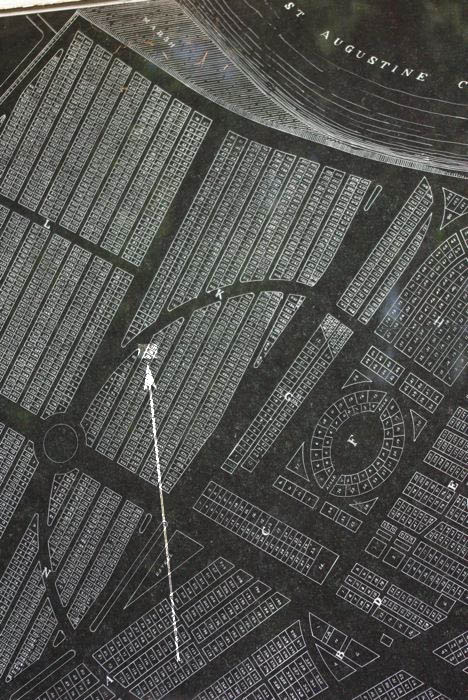
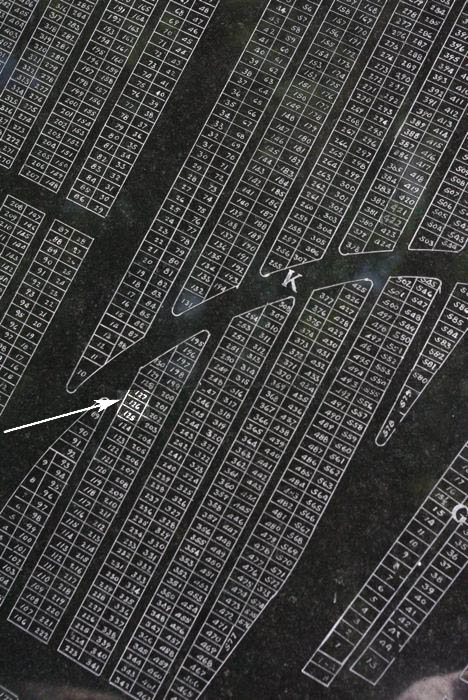

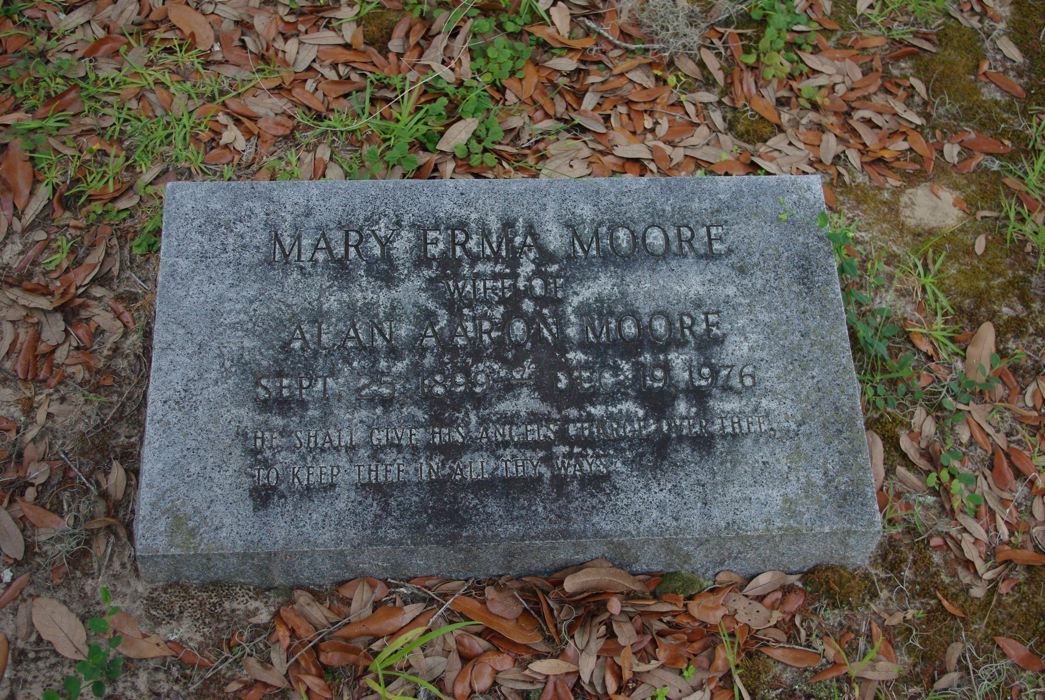
Mary Erma Moore
Wife Of
Alan Aaron Moore
Sept. 25, 1899 - Dec. 19, 1976
"He Shall Give His Angels Charge Over Thee,
To Keep Thee In All Thy Ways"
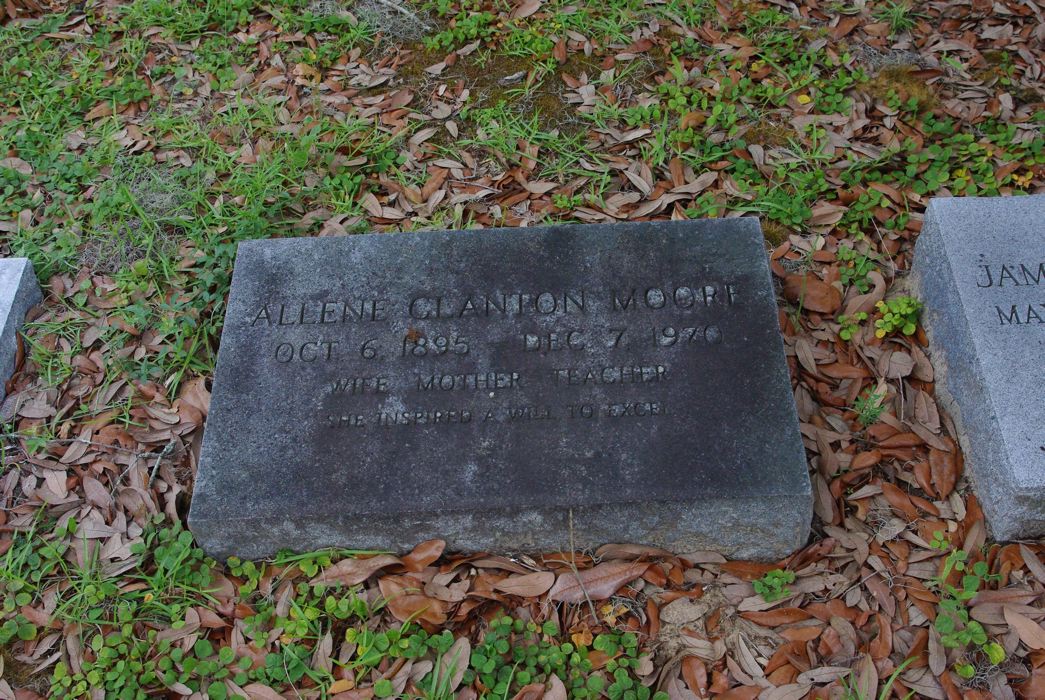
Allene Clanton Moore
Oct. 6, 1895 Dec. 7, 1970
Wife -Mother - Teacher
She Inspired A Will To Excel

James Anderson Moore
May 30, 1921 - Jan. 4, 2002
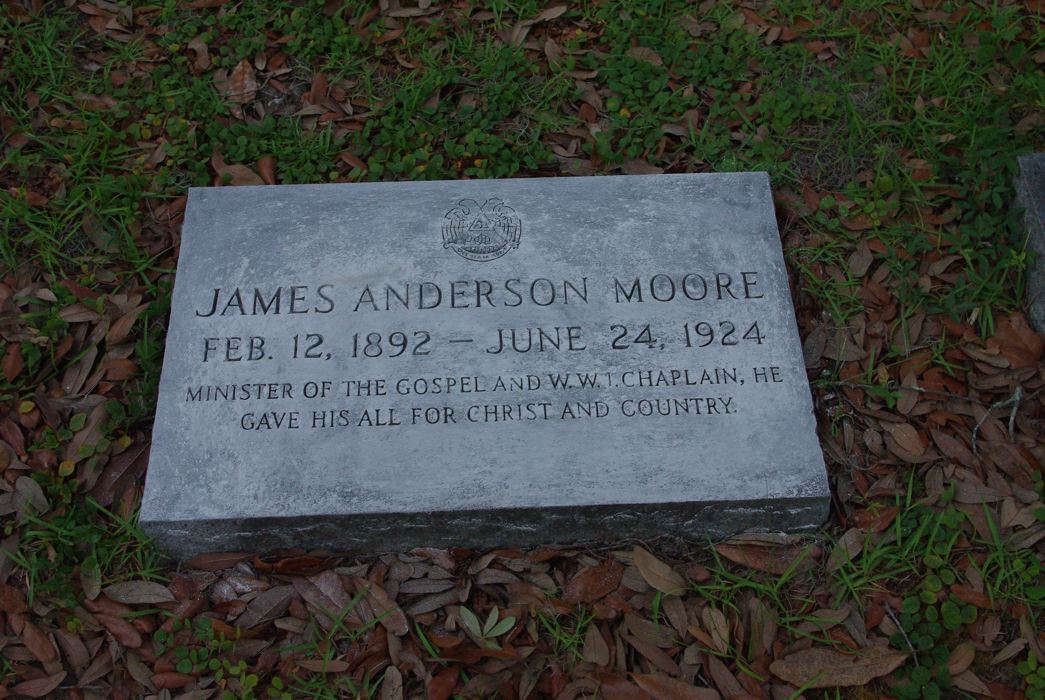
James Anderson Moore
Feb. 12, 1892 - June 24, 1924
Minister of the Gospel And W.W.I. Chaplain, He
Gave His All For Christ And Country
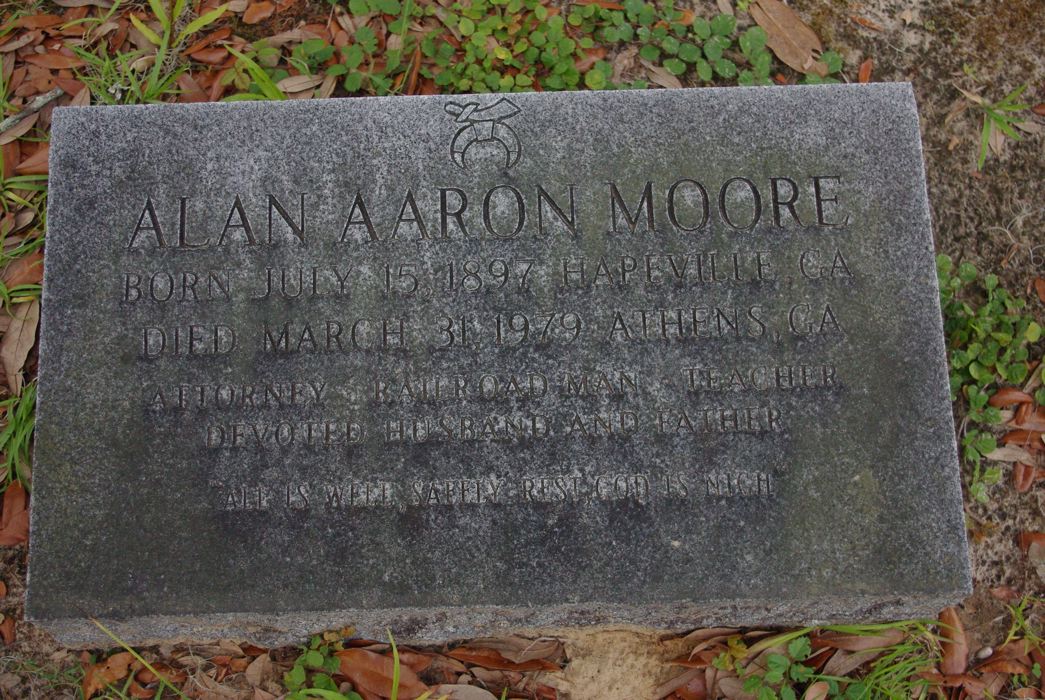
Allen Aaron Moore
Born July 15, 1897, Hapeville, GA.
Died March 31, 1978, Athens, GA
Attorney - Railroad Man - Teacher
Devoted Husband and Father
All Is Well Safely Rest God Is Nigh

Mollie Black Moore
"MEMAMA"
Jan. 19, 1867-July 3, 1958
Devoted Wife, Loving Mother, Beloved
Grandmother, A Friend To All
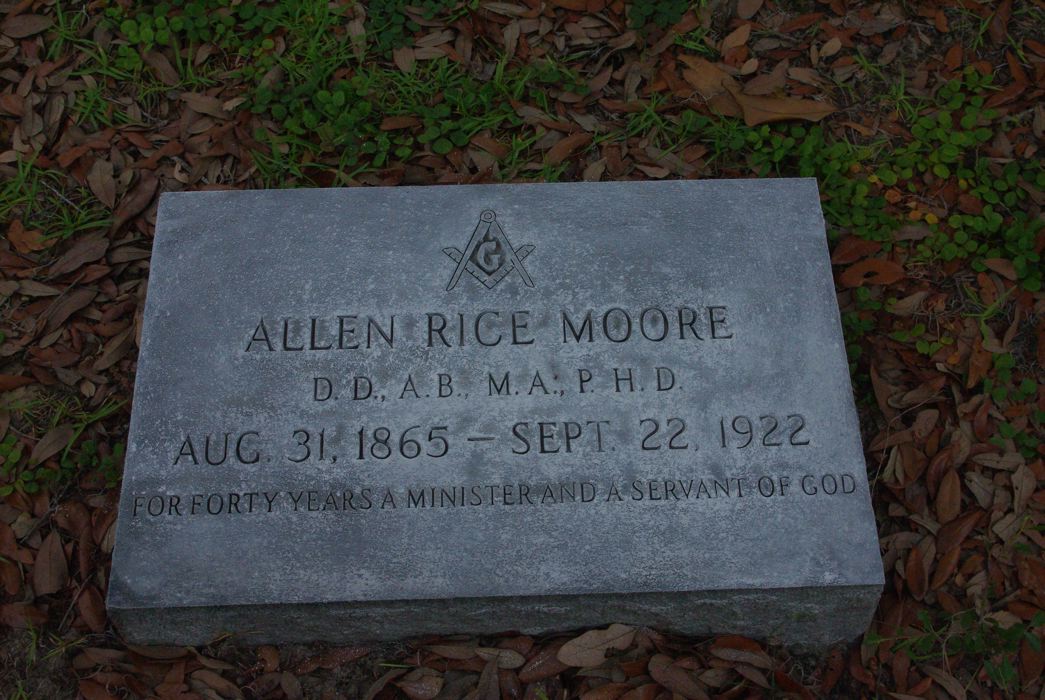
Allen Rice Moore
D.D., A.B., M.A. P.H.D.
Aug. 31, 1865-Sept. 22, 1922
For Forty Years A Minister And Servant Of God
![]()
Special Thanks
Special thanks are extended to C. Wayne Kilpatrick for locating and photographing the final resting place of A.R. Moore. The photos you see on this site were taken and submitted in July, 2010.
![]()